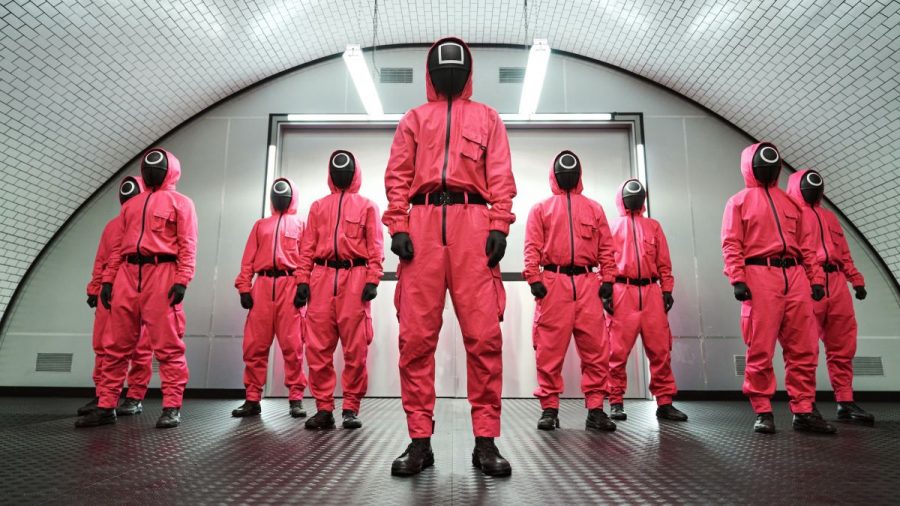Squid Game Hits Different
October 8, 2021
WARNING: MAJOR SPOILER WARNING
In 2008, Hwang Dong-hyuk had an epiphany for a drama series: impoverished people try to repay their debt by competing in children’s games for money. He finished writing it in 2009. According to insider.com, Hwang was forced to stop writing for a time; he had to sell his laptop to keep himself financially afloat. When you think about it, it is truly ironic to almost go into debt to write about people in debt. Unfortunately, streaming services rejected it for several years, saying it was “too grotesque and too unrealistic” (The Journal). Finally, Netflix conceded. On September 17th, 2021, “Squid Game” hit the menus of Netflix. Since then it has skyrocketed in popularity. As of now, according to ABC News, the show “is on track to become the biggest show in Netflix’s history in any language.”
“Squid Game” follows the story of Seong Gi-Hun, an impoverished Korean man struggling to pay off child support and the debt he owes to loan sharks. After the viewer is exposed to his arduous and desperate lifestyle, he is approached by a well-dressed businessman offering to play a game. The mysterious man offers Seong 100,000 won (about 84 USD) every time he won, and, for every time Seong lost, he would get slapped. Already, the viewer is exposed to a major theme of the show: trading one’s body for money. Seong fails multiple times, but he continues to play, further proving his desperation. Finally, he manages to beat the businessman at his own game, winning 100,000 won. However, the businessman had achieved his ultimate goal, for Seong agreed to play a different game for even more money. Unbeknownst to Seong, he was in way over his head, and he would realize that too late.
Seong Gi-Hun is knocked out and poached to a remote island. He wakes up in a mysterious green tracksuit with his new identity: 456. He is surrounded by 455 other strangers in identical attire. Shortly after regaining their bearings, everyone signed a contract that had three rules: 1. You cannot stop playing the game. 2. Refusing to play will result in elimination. 3. The games can be stopped with a majority vote. Then, all players were ushered into a larger area about a soccer field and a half long. On the opposing side of the playing field stood a mechanical baby whose head was attached to a swivel. The PA system announced that all the contestants were going to play red light green light. All players were told that if they moved on a red light, they would be “eliminated.” After player 250 was caught moving by the cameras in the baby’s eyes, he was “eliminated.” At this point, the term “eliminated” was redefined for the remaining plays. It did not mean, simply, that you were out and disqualified from the prize, but it meant that you were executed by gunshot. After the first game, 255 players were killed.
Horrified after the first game, almost everyone was ready to vote to end the games, but they were presented with the prize money: 25.5 billion won (about 21.3 million USD). Additionally, each person who died added 100,000 won into the pot. The voting commenced and the majority barely voted to end the game (101 to 100). The rest of the second episode shows Seong’s and other characters’ lives at home such as a North Korean defector, Kang Sae-Byeok, a violent gangster, Jang Deok-Su, and a smart businessman who has accumulated a mysterious debt, Cho Sang-Woo. The main purpose of this episode is to convey the idea that these people had genuinely nowhere to go besides risking their lives for the money. Of the 201 players, 188 decided to return to play the game.
Throughout the rest of the show, 5 more deadly children’s games are played. The final three contestants were Sae-Byeok, San-Woo, and Seong. San-Woo killed Sae-Byeok in cold blood, and during the final game (a literal fight to the death), San-Woo killed himself, leaving Seong 46 billion won (about 40 million USD). With all this money, Seong decides to put his emigration to the US on halt and pursues the destruction of the games, perfectly setting the series up for another season.
Now that the main gist of the story is out of the way, it’s time for my thoughts on the show.
During the back half of this summer break, I felt starved for Netflix shows. Nothing, in particular, appealed to me. The shows/movies I had already watched felt dated; I did not feel like watching them again. Then, “Squid Game” was released. As it quickly became all the rage, I decided to investigate. After watching all 9 episodes, I can officially say that “Squid Game” is the most disturbing TV show or movie I have ever seen, and here’s why:
Compared to other shows and movies, Squid Game feels the most realistic; in a sense, Squid game “hits different.” A perfect example of a series that conveys a traditional sense of disturbance is the Saw franchise. For those who do not know, Saw is about a vengeful sadist who kidnaps people who he feels have done wrong and puts them through a series of elaborate traps and tests where death is the punishment. The Saw series achieves disturbance through its graphic gore and the over-the-top contraptions people are forced into. However, Squid Game achieves the same level of disturbance by doing just the opposite. In fact, there are no elaborate traps, crazy plot lines, or supernatural elements. It is simple and, most of all, realistic. Millions of people live exactly as the players do in the game: impoverished, indebted, and desperate. It is not completely out of the question that a scenario like Squid Game could happen in today’s world. Another realistic factor of Squid Game is its tendency to dwell on executions. In today’s world of cinema, gunshot deaths are notoriously portrayed off-screen, or, at least, the body and blood are not shown. This is not the case in Squid Game. The creator, Hwang Dong-hyuk, made it a point to showcase dozens of executions in their entirety. This extra element of realistic violence elevates the overall disturbance level of Squid Game.
Squid Game is also disturbing because of the idea of dehumanization. All of the staff wear pink jumpsuits with a mask that designates their rank. While a circle mask is the lowest, the square mask is the highest. They have no personality, no name, and seemingly no friends. They are just vessels of the game: empty and faceless like the masks they wear. As for the players, they are only referred to by their number, not to mention they are murdered often as pigs get slaughtered in the slaughterhouse. Of course, this dehumanization is really symbolic of their inconsequential roles in a larger, competitive society, similar to that of the free market.
I also observed that Squid Game is actually an allegory for capitalism. All 456 players are pitted against each other for money. As the games progresses, the prize gets larger and people begin to lose their humanity in the name of winning, sound familiar? San-Woo is the ultimate example of a person who is corrupted by extreme capitalistic aspects. He begins as Seong’s friend from high school and quickly becomes a member of an alliance between Seong, him, and a few other players. However, towards the end of the series, he turns on everyone he knows. First, he tricked a member of his alliance, getting him executed. Next, he murdered Sae-Byeok. By the end of the show, it is hard to tell if he felt anything in the beginning. I am willing to submit that he did not begin this series as an emotionless sociopath. In fact, he still had humanity in him. When? His decision to kill himself (when Seong refused to kill him) proved that he was ashamed of himself.
On the surface, Squid Game seems like an off-beat thriller drama centered around poor Koreans playing games for money. However, I assure you Hwang had much more in mind for this series, for it features hair-raising realism followed by moral disintegration. On top of that, it acts as a statement that relates to the world today as capitalism continues to dominate not only dozens of countries, but millions of people as well.

